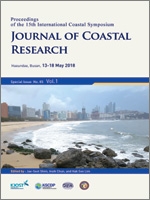Kudryavtseva, N.; Pindsoo, K., and Soomere, T., 2018. Application of Non-stationary Extreme Value Modeling to Account for Trends in Extreme Water Level Changes Along the Baltic Sea Coast. In: Shim, J.-S.; Chun, I., and Lim, H.S. (eds.), Proceedings from the International Coastal Symposium (ICS) 2018 (Busan, Republic of Korea). Journal of Coastal Research, Special Issue No. 85, pp. 586–590. Coconut Creek (Florida), ISSN 0749-0208.
The classic approach to extreme water levels and their return periods relies on the choice of a convenient extreme value distribution and the subsequent evaluation of its parameters. However, there is increasing evidence that these parameters vary with time owing to climate change. A novel non-stationary modeling of parameters of a generalized extreme value (GEV) distribution is implemented based on the block maximum approach, looking for linear trends in the location parameter of the GEV distribution. The analysis is performed for simulated NEMO-Nordic water level data along the Baltic Sea coast for years 1979–2012 with a spatial resolution of ~3.7 km (2 nm) and time resolution of 1 hr. A homogeneous map of the water level 30-yr return values for the coastal regions of the Baltic Sea showed that the highest values (1.0–1.7 m) are in the Gulf of Finland. The results show high spatial variations in linear trends in the location parameter of GEV, indicating, that in case of regional seas, the changes in the extreme value behavior can have a characteristic spatial scale as small as ~100 km. The most notable linear trends are detected along the Pomeranian Bay, where it was found that the difference between non-stationary and stationary 30-yr return values reaches 0.15 m, suggesting that the deviation can be up to 0.5 m for the 100-yr period. Therefore, it is critical to consider non-stationary effects in extreme value modeling for the coastal engineering constructions to prevent underestimation of the risks from the water level extremes.





